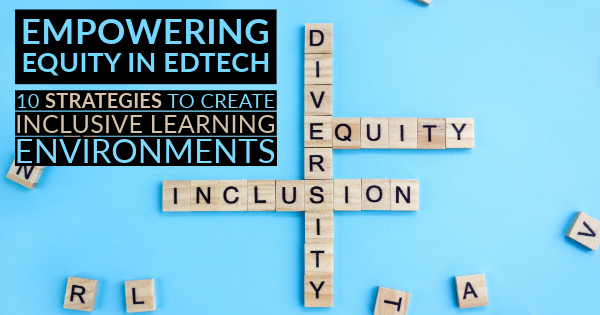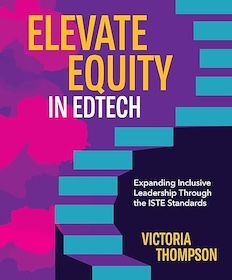10 Strategies to Create Inclusive Learning Environments - Empowering Equity in EdTech
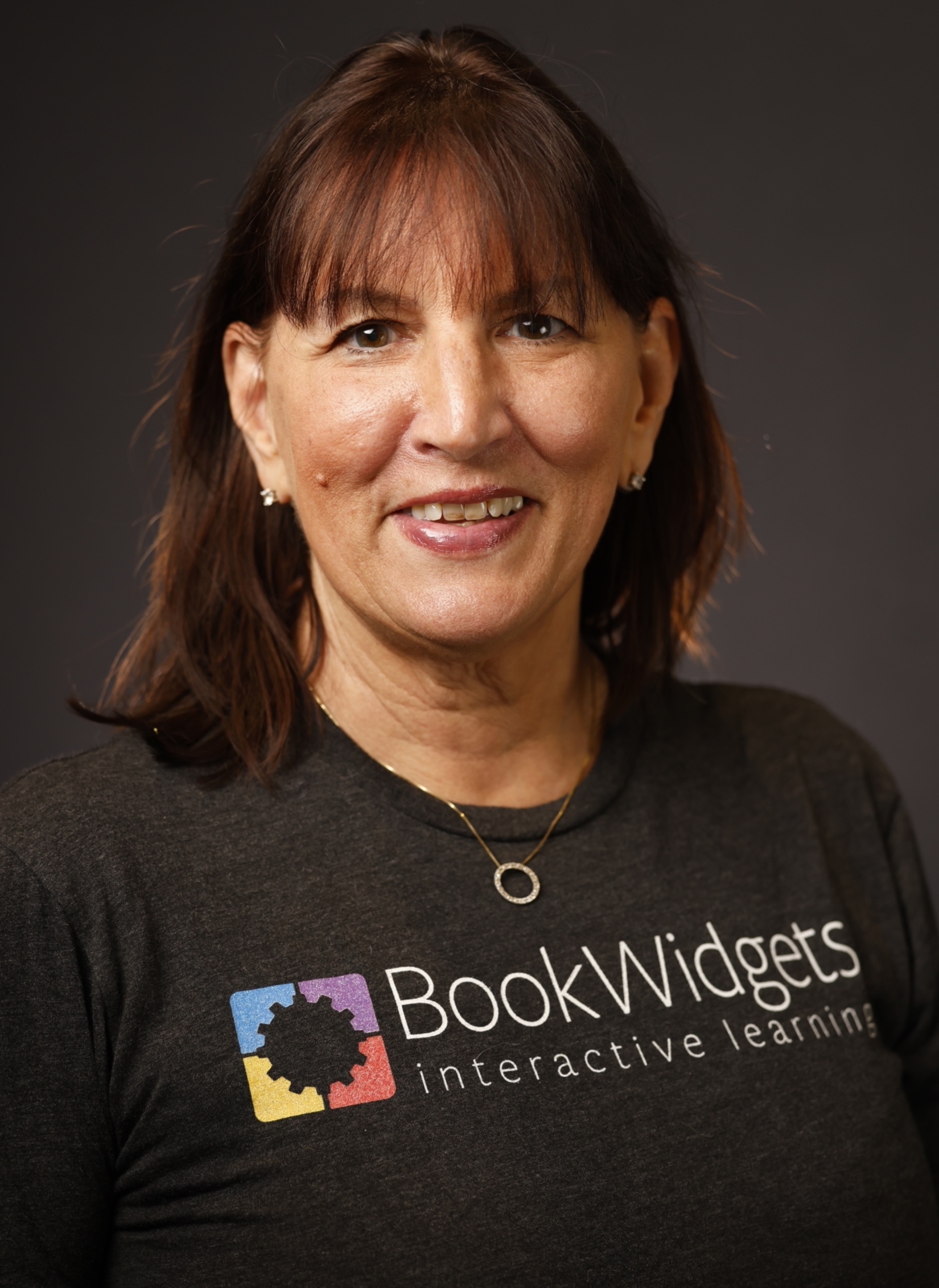 Sheryl Place —
Sheryl Place —
The pursuit of equity stands as a fundamental pillar of progress In education. But what exactly is equity, and how does it differ from equality? Moreover, how can educational technology companies strive for equity in their product development?
In this post, we’ll explore these questions and exhibit how BookWidgets is championing equity in content creation and education.
This blog post is divided into sections:
- Defining Equity
- The Difference Between Equality and Equity
- 10 Strategies to Promote Equity in EdTech

Defining Equity
What does Equity mean? Equity in education revolves around the concepts of fairness and impartiality in lesson creation, instruction, classroom culture and community building - ensuring that every student has access to the resources, support, and opportunities they need to thrive academically and personally. It acknowledges that different students come from varied backgrounds and possess unique needs, requiring tailored approaches to address disparities and foster success. According to the National Equity Project, “Educational equity means that each child receives what they need to develop to their full academic and social potential”.
I recently had a great conversation with Victoria Thompson, K-12 Education Strategist at CDW who provided this example, “equality means that we all have a pair of shoes, but equity means that we all have shoes that fit (properly). A lot of folks like to take a look at equality as the main equalizer in education, when really it’s equity.”
Working towards equity in schools involves:
- Ensuring equally high outcomes for all participants in our educational system; removing the predictability of success or failures that currently correlates with any social or cultural factor;
- Interrupting inequitable practices, examining biases, and creating inclusive multicultural school environments for adults and children; and
- Discovering and cultivating the unique gifts, talents and interests that every human possesses.
To further investigate these 3 principles, I continued my conversation with Victoria, who is the author of Elevate Equity in EdTech. She highlighted:
“I like to refer to equity in education and educational technology as a “team effort.” Being a champion for equity is greater than just yourself–it means that you need to have a team of like-minded folks around you to advance these goals and initiatives. Things like encouraging educators to use accessibility features like live captions when facilitating a lesson, lesson-planning with differentiated learning in mind, and vetting edtech tools with an equity lens…these are practices that, when implemented by an entire school or district, do not happen overnight. There needs to be buy-in and there has to be support. When you have a strong team of people who want to see equity in action, it makes the implementation process so much simpler.”

The Difference Between Equality and Equity
Now that you understand what “Equity” is, you must also understand the meaning of “Equality” as well. Here’s how we set the two apart: while equality aims to treat everyone the same, equity recognizes that not all students start from the same place or require the same support to succeed.
Imagine a scenario where all students are given the same size box to stand on to watch a sporting event over a fence. Equality would mean each student receives the same box, regardless of their height or personal needs. Equity, on the other hand, would involve providing taller boxes to shorter students and shorter boxes to taller students, or a ramp for students in a wheelchair, ensuring that everyone has an equal view of events.
It refers to this powerful image.
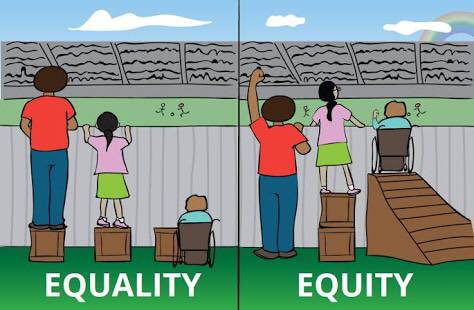
A personal observation comes from my teaching 9th grade English Language Arts to multilingual learners (English Language Learners). The students were provided the exact same text as the general education native speakers, however, they received limited scaffolding or support to comprehend the content and navigate reading in a second or third language. This may have demonstrated equality, but certainly not equity. Where have you seen differences between equity and equality in your instruction or instructional materials?

Promoting Equity in EdTech
EdTech companies play a pivotal role in shaping the educational landscape, and it’s imperative to embed principles of equity into product development processes. Here are some ways we can all strive for equity.
BookWidgets’ approach: BookWidgets stands at the forefront of promoting equity in education through its innovative content creation and evaluation platform. With features designed to accommodate diverse learning needs and preferences, BookWidgets empowers educators to create engaging and inclusive lessons for all students.
💡 New to BookWidgets? BookWidgets is a content creation and evaluation tool for teachers. They provide the tools to support your students’ learning process from beginning to end with customizable templates (aka widgets) for creating activities and a reporting dashboard to track your students’ progress. By clicking on this link you can access all the activities mentioned in this blog post.
1. User-Centered Design
 As a company, prioritize understanding the diverse needs of students and educators from various backgrounds and abilities through extensive research and feedback loops. Meet with current and potential users to listen to their feedback and provide opportunities to address praise as well as constructive feedback.
As a company, prioritize understanding the diverse needs of students and educators from various backgrounds and abilities through extensive research and feedback loops. Meet with current and potential users to listen to their feedback and provide opportunities to address praise as well as constructive feedback.
BookWidgets’ approach: Central to our user-centered design approach are BookWidgets Ambassadors, who play a vital role in providing valuable feedback. Ambassadors help ensure that our product meets the needs of teachers and students by testing and confirming the efficacy of our solutions across various educational contexts. BookWidgets is developed for all educators, based on their feedback. Our users, the teachers, can also reach out to our support team to provide feedback and request features.
2. Accessibility Features
 Companies have a responsibility to ensure that educational resources and platforms are accessible to all students, including those with disabilities, by incorporating features such as screen readers, alternative text, and adjustable font sizes. These accessibility features are great options to incorporate in lesson design for all learners, not only those with an educational plan or mandated accommodations. Using the pillars of Universal Design for Learning (UDL) is a great place to look for resources and guides to ensure lessons and content creation are accessible to all. Check out CAST - Center for Applied Special Technology for more information on UDL.
Companies have a responsibility to ensure that educational resources and platforms are accessible to all students, including those with disabilities, by incorporating features such as screen readers, alternative text, and adjustable font sizes. These accessibility features are great options to incorporate in lesson design for all learners, not only those with an educational plan or mandated accommodations. Using the pillars of Universal Design for Learning (UDL) is a great place to look for resources and guides to ensure lessons and content creation are accessible to all. Check out CAST - Center for Applied Special Technology for more information on UDL.
BookWidgets’ approach: We list and demonstrate our accessibility efforts in this blog post. Make sure to go through the post as you will discover valuable accessibility tools for your lessons.
3. Multimodal Learning: Embracing Diverse Learning Styles
 Companies recognize that students possess a myriad of learning preferences and abilities. In turn the product should acknowledge and embrace this diversity by offering a range of content formats to cater to various methods of understanding and learning. At its core, multimodal learning is about presenting information in multiple ways, allowing students to engage with the material through their preferred sensory channels.
Companies recognize that students possess a myriad of learning preferences and abilities. In turn the product should acknowledge and embrace this diversity by offering a range of content formats to cater to various methods of understanding and learning. At its core, multimodal learning is about presenting information in multiple ways, allowing students to engage with the material through their preferred sensory channels.
By offering diverse content formats encompassing text, audio, video, and interactive elements, educators can create a rich learning environment that accommodates the varied needs and preferences of their students. This holistic approach to instruction fosters engagement, comprehension, and retention, ultimately empowering learners to succeed across diverse learning contexts.
BookWidgets’ approach:
- Text: Traditional written text remains a fundamental component of educational resources, providing a foundational medium for conveying information and concepts. Text-based materials offer students the opportunity to engage in close reading, critical analysis, and comprehension exercises. 💡Learn more about using text options to spice up your content creation
- Audio: Incorporating audio elements into learning materials can enhance engagement and comprehension for auditory learners. Audio resources such as podcasts, recorded lectures, or audio descriptions of visual content provide an alternative means of accessing information, particularly for students who benefit from listening and verbal processing. 💡Read more on how BookWidgets incorporates audio into question formats.
- Video: Visual learners often thrive when presented with video content, as it offers dynamic visuals and audio components that reinforce learning. Educational videos, animations, and multimedia presentations can effectively illustrate complex concepts, processes, and scenarios, making abstract ideas more tangible and accessible. 💡The BookWidgets Video Quiz is the perfect tool for multimodal learning.
- Interactive Elements: Interactive elements, such as simulations, games, quizzes, and virtual labs, invite active participation and hands-on exploration. These immersive experiences not only capture students’ interest but also facilitate experiential learning, allowing them to manipulate variables, test hypotheses, and observe outcomes in real-time. 💡The BookWidgets Hotspot Image widget is perfect for adding interactive elements into a lesson.
4. Cultural Relevance
 Incorporate diverse perspectives, cultures, and identities into educational content to foster inclusivity and representation. Again, from CAST, “In 2020, CAST launched our most recent effort to update the UDL Guidelines. This update focuses specifically on updating the Guidelines through an equity lens. While the Guidelines have become a valuable tool to help practitioners design for learner variability, we recognize that gaps and biases exist. There has been a strong call from the field—both practitioners and researchers alike—to more fully develop the Guidelines to address critical barriers rooted in biases and systems of oppression. The current update aims to respond to this call and to work toward fulfilling the promise of the Guidelines as a tool to guide the design of learning environments that more fully honor and value every learner.”
Incorporate diverse perspectives, cultures, and identities into educational content to foster inclusivity and representation. Again, from CAST, “In 2020, CAST launched our most recent effort to update the UDL Guidelines. This update focuses specifically on updating the Guidelines through an equity lens. While the Guidelines have become a valuable tool to help practitioners design for learner variability, we recognize that gaps and biases exist. There has been a strong call from the field—both practitioners and researchers alike—to more fully develop the Guidelines to address critical barriers rooted in biases and systems of oppression. The current update aims to respond to this call and to work toward fulfilling the promise of the Guidelines as a tool to guide the design of learning environments that more fully honor and value every learner.”
BookWidgets’ approach: BookWidgets is a teacher content creation and evaluation tool. As teachers create content they may want to add specific support found in the BookWidgets editor. These include general language supports, text direction and translation. Additionally, I would recommend adding in audio and video closed captioning for all sudents in either their first language or a supported language.
5. Flexible Customization: Empowering Educators to Personalize Learning Experiences
 In the dynamic landscape of education, every classroom is a tapestry of unique learners, each with their own strengths, challenges, and interests. Flexible customization stands as a cornerstone of effective pedagogy, offering educators the tools and autonomy to craft learning experiences that resonate with the individual needs and preferences of their students.
In the dynamic landscape of education, every classroom is a tapestry of unique learners, each with their own strengths, challenges, and interests. Flexible customization stands as a cornerstone of effective pedagogy, offering educators the tools and autonomy to craft learning experiences that resonate with the individual needs and preferences of their students.
Tailored Instruction: Flexible customization empowers educators to tailor instruction to address the diverse learning styles, abilities, and interests present within their classroom. By offering customizable lessons, educators can scaffold learning experiences, differentiate instruction, and provide targeted interventions to support students at various proficiency levels. With one click easy customization, BookWidgets provides ease of content creation for educators.
Adaptability: In a rapidly evolving educational landscape, the ability to adapt and iterate instructional materials is paramount. Flexible customization enables educators to respond to emerging trends, student feedback, and evolving pedagogical best practices, ensuring that learning experiences remain relevant, engaging, and effective.
Personalization: Recognizing that one size does not fit all, flexible customization allows educators to personalize learning experiences to meet the unique needs and interests of each student. Whether through differentiated assignments, choice-based activities, or personalized learning paths, educators can foster a sense of ownership and agency among students, empowering them to take ownership of their learning journey.
Inclusive Design: Flexible customization embraces the principles of universal design for learning (UDL), ensuring that instructional materials are accessible and inclusive for all students, regardless of their background, abilities, or learning preferences. By offering customizable options such as adjustable font sizes, language support, and multimedia alternatives, educators can create inclusive learning environments that accommodate diverse learners.
Engagement and Motivation: Personalized learning experiences are inherently more engaging and motivating for students, as they feel a sense of agency and relevance in their learning journey. By incorporating student interests, real-world connections, and choice-based activities, educators can cultivate a culture of intrinsic motivation and lifelong learning.
In essence, flexible customization empowers educators to design learning experiences that are responsive, inclusive, and engaging, ultimately fostering student success and promoting a love for learning that extends beyond the classroom walls. By embracing the principles of flexibility and customization, educators can unlock the full potential of every learner, ensuring that education remains a transformative and empowering experience for all.
BookWidgets’ approach: Check out this blog post featuring the Planner Widget in which teachers can collect multiple activities to create personalized learning plans for their students. As teachers can easily duplicate any of the activities they create in BookWidgets, it allows them to alter the activities to the students needs and create personalized assignments
6. Customizable Content
 Educators can easily personalize lessons with a wide range of interactive widgets, allowing them to cater to individual learning styles and preferences. Differentiating Instruction:
Educators can easily personalize lessons with a wide range of interactive widgets, allowing them to cater to individual learning styles and preferences. Differentiating Instruction:
- Tailoring lessons to accommodate various learning styles and abilities within the classroom.
- Providing alternative assessment methods that allow students to showcase their understanding in different ways.
BookWidgets’ approach: We provide “Widget Groups” in which teachers can share their designed lessons - or widgets - with other teachers, allowing them to duplicate those materials and customize them to their needs and their student’s needs.
Check out this widget activity which incorporates a randomness widget, audio support and more. While the audio and photo questions are included, this activity can be duplicated and customized to meet the needs of all students in the classroom. For example, one widget could have the writing assignment, another widget could have the audio assignment and the third widget could contain the photo assignment option.

Click to open
7. Flexible and Inclusive Assessment Practices
 As demonstrated in the example above, employing a range of assessment formats tailored to students’ strengths fosters equity in assignments and evaluations. Additionally, providing extra support and accommodations during assessments is crucial for ensuring fair evaluation for all students.
As demonstrated in the example above, employing a range of assessment formats tailored to students’ strengths fosters equity in assignments and evaluations. Additionally, providing extra support and accommodations during assessments is crucial for ensuring fair evaluation for all students.
BookWidgets’ approach: For instance, consider this math video exit ticket, which allows students to assess their comprehension using both emojis and a rubric. The video features customized closed-captions in Spanish, further enhancing support for multilingual learners. Importantly, these features are customizable by the instructor to meet diverse student needs.
For instance, consider this math video exit ticket, which allows students to assess their comprehension using both emojis and a rubric. The video features customized closed-captions in Spanish, further enhancing support for multilingual learners. Importantly, these features are customizable by the instructor to meet diverse student needs.
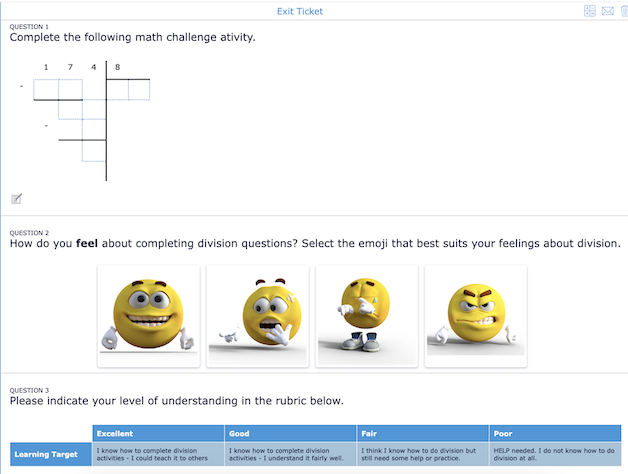
Click to open
8. Accessibility Tools
 Accessibility tools are features or accommodations implemented in educational technology (edtech) platforms to ensure that all students, regardless of their abilities or disabilities, can access and engage with the learning content effectively. These tools aim to remove barriers to learning and provide equitable opportunities for all learners to succeed.
Accessibility tools are features or accommodations implemented in educational technology (edtech) platforms to ensure that all students, regardless of their abilities or disabilities, can access and engage with the learning content effectively. These tools aim to remove barriers to learning and provide equitable opportunities for all learners to succeed.
Some examples of accessibility tools that edtech companies could integrate into their platform include:
Text-to-Speech (TTS): This tool converts written text into spoken words, allowing students with visual impairments or reading difficulties to listen to the content instead of reading it.
Screen Readers: Screen readers are software programs that interpret and verbalize the content displayed on a computer screen. They are essential for students who are blind or have low vision to navigate digital content.
Adjustable Font Sizes and Styles: Allowing users to customize the font size, style, and spacing can enhance readability for students with visual impairments or dyslexia.
Closed Captioning: Providing captions for videos ensures that students who are deaf or hard of hearing can access the spoken content.
Alternative Text (Alt Text): Alt text is a brief description of an image that is read aloud by screen readers. It enables students with visual impairments to understand the content of images.
Color Contrast Options: Adjustable color contrast settings can benefit students with visual impairments or color vision deficiencies by making content more readable.
Keyboard Navigation: Offering keyboard shortcuts and alternative navigation methods ensures that students with mobility impairments can navigate the platform efficiently without relying on a mouse.
Language Support: Providing multilingual options or translation tools facilitates access to content for students who are English Language Learners or speak languages other than the primary language of instruction.
Audio Descriptions: These are verbal narrations that describe visual elements in videos or multimedia content for students who are blind or have low vision.
Interactive Elements: Designing interactive elements with accessibility in mind ensures that all students, including those with disabilities, can actively participate in learning activities.
By incorporating these accessibility tools into their platforms, edtech companies can create inclusive learning environments that accommodate the diverse needs of all students and promote equitable access to education.
BookWidgets’ approach: BookWidgets provides a range of accessibility features, including text-to-speech functionality, customizable fonts, rich text formatting, and support for audio and video. These features ensure that educational content remains accessible to students with diverse needs. Explore our engaging spring Easter quiz to experience firsthand examples of how these features, such as audio support and text-to-speech, enhance accessibility. This interactive quiz offers various customization options, including designs tailored for students with color vision deficiencies. Take note of the unique question designs in questions four and five, showcasing design options used to support students who may have color vision deficiency.
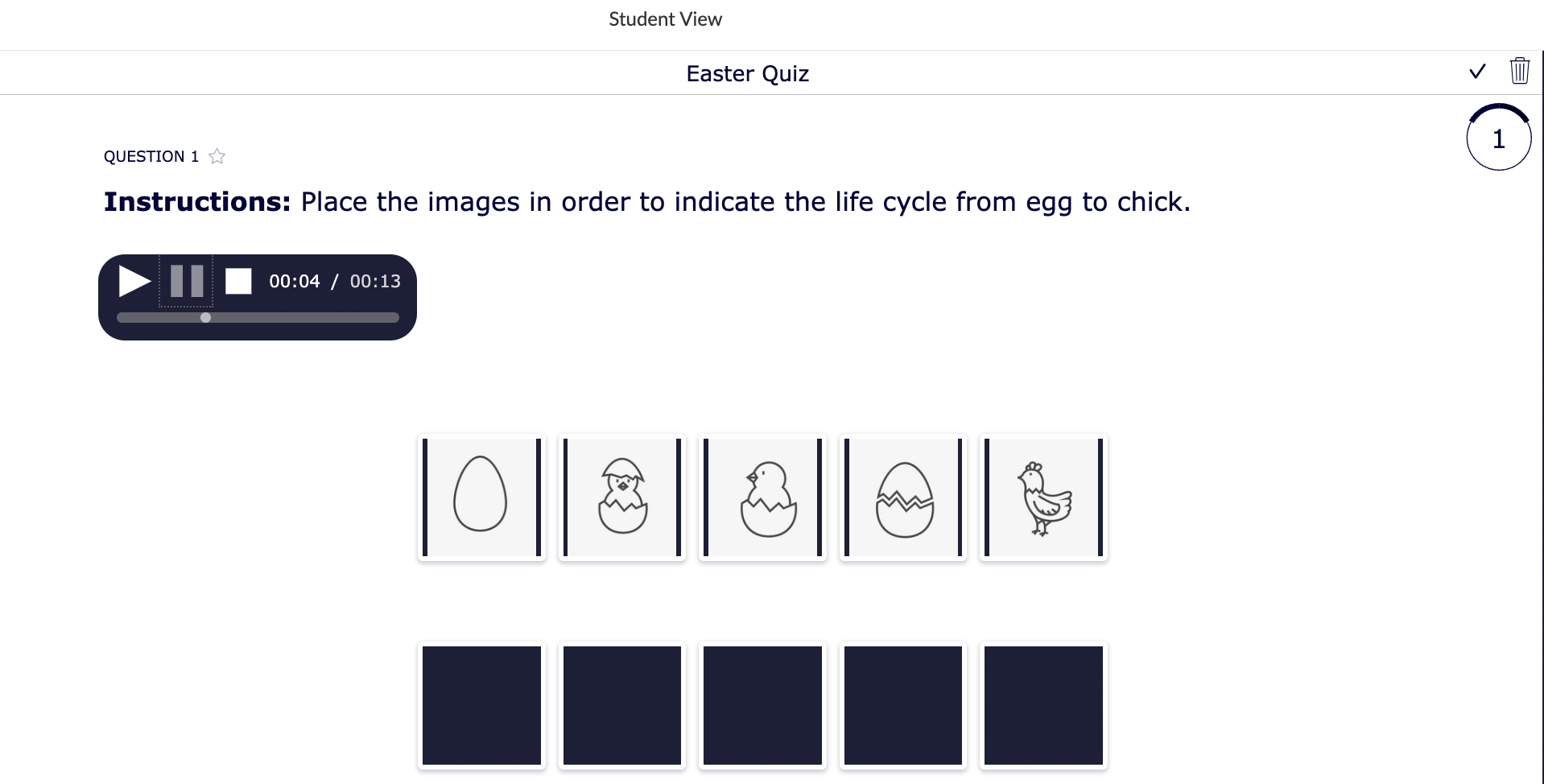
Click to open
9. Diverse Content Library
 A diverse content library should encompass a wide range of educational resources that cater to the varied needs, interests, and learning styles of students across different grade levels, subjects, and cultural backgrounds. A diverst content library would aim to provide educators with a rich array of content options to enhance teaching and learning experiences in diverse classrooms. BookWidgets is a content creating tool, teachers create the content, thus ensuring that it is diverse.
A diverse content library should encompass a wide range of educational resources that cater to the varied needs, interests, and learning styles of students across different grade levels, subjects, and cultural backgrounds. A diverst content library would aim to provide educators with a rich array of content options to enhance teaching and learning experiences in diverse classrooms. BookWidgets is a content creating tool, teachers create the content, thus ensuring that it is diverse.
BookWidgets’ approach: While the focus of BookWidgets is to help teachers create engaging content, there is also a rich library of ready-made widgets that users may select and duplicate. Drawing from content created by a diverse community of educators spanning a variety of subjects, content areas, and creation styles, BookWidgets enables educators to incorporate culturally relevant, equitable, and engaging content into their lessons. Join the BookWidgets blog group to find content that is perfect for your learners. You can find just about anything from a Worksheet filled with rebuses on Famous Female Mathematicians to a WebQuest on Dìa de los Muertos.
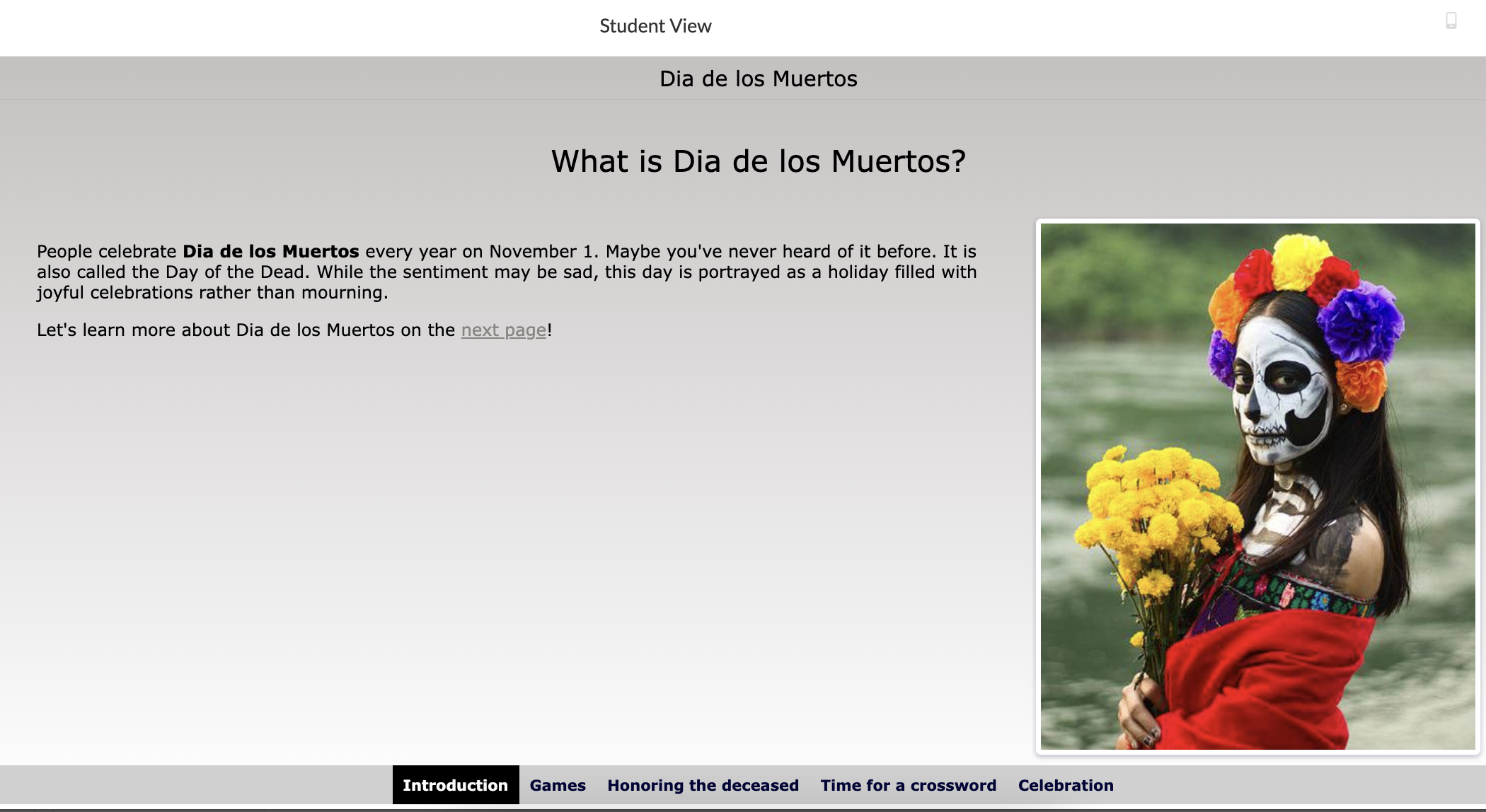
Click to open
10. User-Focused Approach
 A user-focused approach to content creation involves designing and developing educational materials with the specific needs, preferences, and abilities of users in mind. We can begin creating content by understanding user needs and gaining a deeper understanding of our learners. One example would be to design interactive and engaging materials that encourage active learning and participation which may involve incorporating multimedia elements, gamification, simulations, and hands-on activities to enhance student engagement and comprehension. By adopting a user-focused approach to content creation, eductors can develop materials that are not only effective and impactful but also resonant with the needs and preferences of their students. This ultimately leads to more engaging, inclusive, and successful learning experiences for educators and students alike.
A user-focused approach to content creation involves designing and developing educational materials with the specific needs, preferences, and abilities of users in mind. We can begin creating content by understanding user needs and gaining a deeper understanding of our learners. One example would be to design interactive and engaging materials that encourage active learning and participation which may involve incorporating multimedia elements, gamification, simulations, and hands-on activities to enhance student engagement and comprehension. By adopting a user-focused approach to content creation, eductors can develop materials that are not only effective and impactful but also resonant with the needs and preferences of their students. This ultimately leads to more engaging, inclusive, and successful learning experiences for educators and students alike.
BookWidgets’ approach: BookWidgets prioritizes user feedback and continually iterates its platform to better serve the evolving needs of educators and students, fostering a culture of inclusivity and collaboration. Submit feedback, questions or general inquiries to our support team.
Conclusion
Fostering equity in classroom lessons is not just about creating an equal learning environment; it is also about acknowledging and celebrating the unique strengths and challenges of each student in the classroom.
By embracing a commitment to equity, educators contribute to the creation of inclusive classrooms where every student has the opportunity to thrive. In doing so, they not only prepare students for academic success but also empower them to navigate a diverse and interconnected world with empathy and understanding.
Equity in education is not merely a lofty ideal but a crucial imperative for fostering a truly inclusive and just learning environment and school community. It is through acknowledging and addressing the diverse needs of students that we can ensure that every individual has the opportunity to succeed - regardless of their background or circumstances. As we navigate the ever-evolving landscape of educational technology, it’s essential to prioritize equity in the product development processes.
BookWidgets exemplifies this commitment to equity through its user-focused approach and innovative features designed to empower educators and support diverse learners. By embracing principles of accessibility, customization, and inclusivity, BookWidgets helps educators create content and provide a more equitable educational experience for all.
As educators, administrators, and rights-holders in the education community, we will continue to champion equity in education and work towards creating a future where every student has the resources and support they need to thrive. Together, we can build a brighter and more equitable tomorrow. As Victoria so eloquently said, “Equity is everybody’s respnosibility.”
Want to learn more about creating engaging lesson activities with BookWidgets?
✔️ Follow BookWidgets on X / Twitter and LinkedIn and join our teacher community on Facebook!
